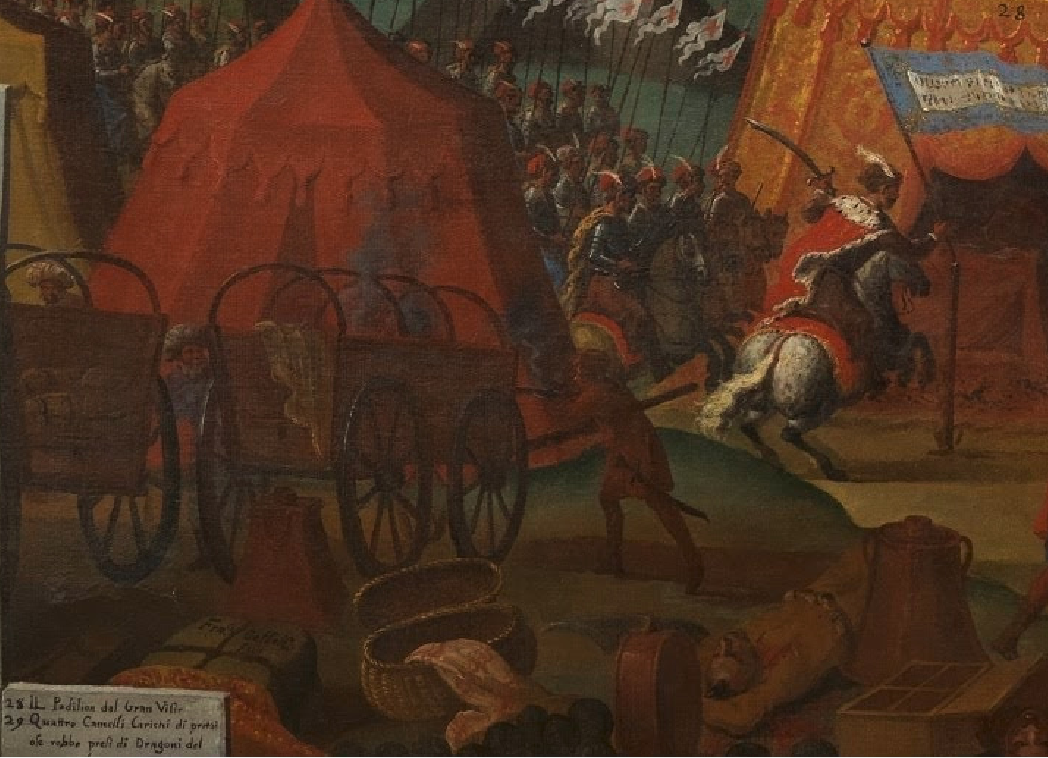Salvete Omnes,
and this year we have a rather rounder anniversary of the battle of Vienna 1683.
Perhaps we should remember the horses - the countless thousands of cavalry mounts and perhaps at least 12 thousands of draft horses pulling 6,000 wagons of the Polish army wagon train. These horses suffered a lot, once they entered the Tatar-ravaged lands of Hapsburg realm, living on twigs and tree leaves, which caused many of them to die before, during and after the battle, until they left the Vienna area in late September 1683.
ad rem, tres amigos of Kara Mustapha court tale.
Podstoli (deputy pantier) of Latyczow of Podole Mikolaj Dyakowski, a scion of old Polish-Hungarian Podolian family and grandson of Pancerny banner rotameister Siemion and princes Woroniecka, was a pokojowiec (valet) courtier of Jan III Sobieski and of his own coat of arms, . He quite being a courtier to the king in 1684 and became a Vallachian (light) cavalry banner companion and circa 1688 became a commanding officer or porucznik of one Wallachian banner. H took part in the Moldavian campaigns and during one such expedition in 1691 he took his banner, along the Turkull brothers' two banners, marched away from the royal army. This act of disobedience in fact was the end of this military career under Jan III.
***
Under the new Saxon king, Augustus the Strong, he became a podstoli of Latyczow and circa 1717 wrote his memoirs (a Dyariusz) about his military experiences during Jan III Sobieski. written with a decent dose of self-control and without aggrandizing his own exploits but much dislike and a scorn towards king Jan III. Pan Mikolaj is supposed to have died circa 1726 or shortly after, but in fact the information about his life post-1712 is non-existent, but for the note in his Dyariusz.
***
Dyariusz was published at least 10 times between 1823-1883, and the Juliusz Kossak illustrations come from the 1883 edition. Dyakowski's writings inspired Wincenty Pol and Jozef Ignacy Kraszewski. The details about the campaign have been cited in many historical works by Polish historians over the years. The XX century edition was edited and published by Jozef Dlugosz and Jozef Adam Kosinski in 1983 - 300 years of the battle - and is available on Archive.
 |
| a detail of Turkish camp from a painting by Frans Geffels |
So in his Dyariusz pan Mikolaj wrote that on the morning the battle about 9A.M. the filed guard brought three young men to the King.
So standing before victorious Jan III these three young men declared themselves valets of the Ottoman commander and Grand Vizier Kara Mustafa Pasha. They claimed they had been taken captive in Podole (Podolia) and Wolyn (Volhynia) Lands when very young. One was Pochojski, a Polish nobleman from Wolyn, where he had some land and brothers who would not disclaim his tale. The other two were named Skalka and Podolski, and could not account of any past nor noble connections being very small when kidnapped, so the court thought them to be some townsmen children when taken by the Tatars.
They all arrived at the king's tent on horseback, each with a retinue of several Turkish and Greek servants. also mounted. They had fine Turkish horses and each of them had huge amounts on money in their coffers - Pochojski 45,000 gold ducats, Skalka 42,000 gold ducats, hile Podolski 39,000 ducats. They claimed that when the battle was lots their lord, Grand Vizier yelled to his servants to grab everything and anything what they could. So they did, and being Christians they decided to return themselves to the Christian side.
They were dressed very richly and splendidly, the three 'amigos' wore beautifully made Ottoman coats of mail armor, with rich golden adornments with rubies precious stones mounted on them - here Dyakowski said that one of this chain-mail armors would end in the treasury of castellan of Krakow [Adam] Sieniwski (according to the 1983 Dyairusz edition notes) .
So when our king Jan III returned to Krakow on Christmas Eve 1683, he asked his courtiers about the whereabouts of those three Grand Vizier valets. He was told that they were partying constantly, had themselves mistresses and were spending their money fast and furious.
The king called them hultaje - or good-for-nothings and commented that nothing good would come out of that. And - wrote Dyakowski - our king left them neglected, and they lost everything and eventually became quite beggars and ended their lives in a misery and want.
So ends the tale of three amigos of Grand Vizier court.
enjoy
Valete








1 comment:
https://en.wikipedia.org/wiki/Three_Amigos the film
Post a Comment